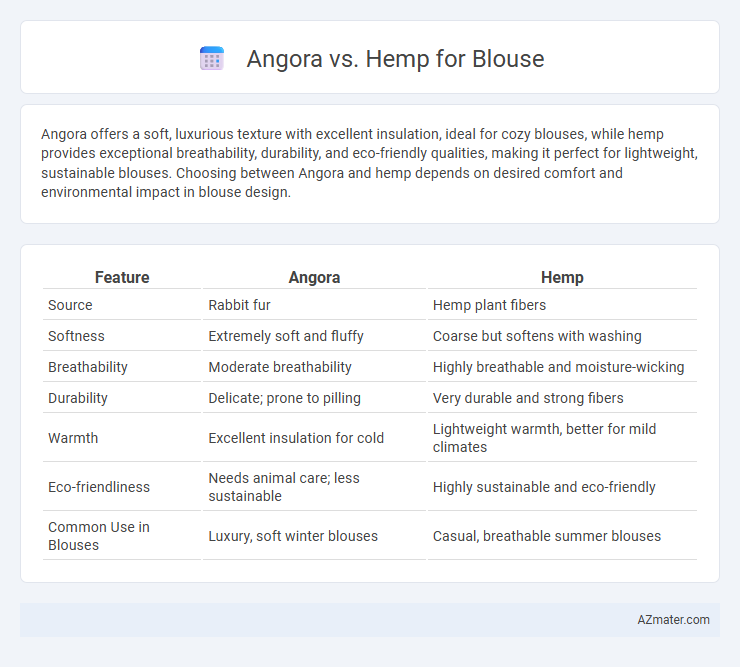Angora offers a soft, luxurious texture with excellent insulation, ideal for cozy blouses, while hemp provides exceptional breathability, durability, and eco-friendly qualities, making it perfect for lightweight, sustainable blouses. Choosing between Angora and hemp depends on desired comfort and environmental impact in blouse design.
Table of Comparison
| Feature | Angora | Hemp |
|---|---|---|
| Source | Rabbit fur | Hemp plant fibers |
| Softness | Extremely soft and fluffy | Coarse but softens with washing |
| Breathability | Moderate breathability | Highly breathable and moisture-wicking |
| Durability | Delicate; prone to pilling | Very durable and strong fibers |
| Warmth | Excellent insulation for cold | Lightweight warmth, better for mild climates |
| Eco-friendliness | Needs animal care; less sustainable | Highly sustainable and eco-friendly |
| Common Use in Blouses | Luxury, soft winter blouses | Casual, breathable summer blouses |
Introduction to Angora and Hemp Fabrics
Angora fabric is derived from the soft, fine hair of Angora rabbits, prized for its luxurious warmth, lightweight texture, and natural insulation properties. Hemp fabric, made from the fibers of the hemp plant, offers exceptional durability, breathability, and sustainability due to its eco-friendly cultivation and resistance to mold and UV rays. Both fabrics provide unique benefits for blouses, with Angora focusing on softness and warmth, while hemp emphasizes strength and environmental impact.
Origin and Production Processes
Angora fibers originate from the Angora rabbit, primarily produced in China, France, and Chile through a gentle combing process that ensures soft, lightweight wool with excellent insulation properties. Hemp fibers come from the industrial hemp plant, cultivated in countries like China, Canada, and the United States, harvested through mechanical decortication and retting processes that separate strong and durable bast fibers ideal for textile production. While Angora production emphasizes animal welfare and careful fiber extraction, hemp production focuses on eco-friendly, sustainable methods, making both fibers distinct in origin and processing for blouse fabrics.
Texture and Comfort Comparison
Angora fabric offers a soft, silky texture with excellent insulation, making blouses warm and cozy but potentially prone to delicate care requirements. Hemp fabric features a coarser, sturdy texture with excellent breathability and moisture-wicking properties, providing durable comfort ideal for warmer climates. Both materials bring unique tactile experiences, with Angora prioritizing softness and warmth and Hemp emphasizing durability and cooling comfort.
Durability and Longevity
Angora fabric, derived from the Angora rabbit, offers softness and warmth but tends to be less durable compared to hemp due to its delicate fibers prone to pilling and wear. Hemp fabric is highly durable, with strong, long-lasting fibers that resist tearing and maintain structural integrity even after multiple washes, making it ideal for blouse longevity. Choosing hemp enhances a blouse's lifespan, while Angora provides comfort at the expense of durability.
Breathability and Moisture-Wicking
Hemp fabric offers superior breathability and moisture-wicking properties compared to Angora, making it ideal for blouses worn in warm or humid conditions. While Angora provides softness and warmth, its dense fibers tend to retain moisture, reducing airflow and comfort during extended wear. Hemp's natural antimicrobial qualities and quick-drying nature enhance wearer comfort, promoting a cooler, drier experience throughout the day.
Environmental Impact and Sustainability
Angora sweaters demand high resource inputs and pose ethical concerns with animal welfare, whereas hemp cultivation requires minimal water, pesticides, and regenerates soil quality, making it a highly sustainable fiber choice. Hemp fabric production emits significantly less greenhouse gas compared to the intensive processing methods for angora wool. Choosing hemp for blouses supports lower environmental footprint and promotes eco-friendly textile practices in the fashion industry.
Care and Maintenance Requirements
Angora blouses require gentle hand washing or dry cleaning to maintain the softness and prevent fiber damage, with careful drying flat to avoid stretching. Hemp blouses are more durable and can often be machine washed in cold water, but benefit from air drying to preserve fabric integrity and reduce shrinkage. Proper storage away from direct sunlight helps maintain the color and quality of both Angora and hemp garments.
Price and Market Availability
Angora fabric tends to be significantly more expensive than hemp due to its labor-intensive production and luxury status, often retailing at higher price points in niche markets. Hemp fabric is more widely available, benefitting from sustainable cultivation practices and increasing popularity in eco-friendly fashion, which drives more competitive pricing. Market availability for hemp blouses is broader across mainstream retailers, while Angora blouses are typically found in specialty boutiques or premium fashion outlets.
Popular Fashion Trends
Angora and hemp fabrics are gaining traction in popular fashion trends for blouses due to their unique textures and sustainability profiles. Angora offers a soft, luxurious feel, often associated with high-end, cozy knitwear, while hemp provides a durable, breathable, and eco-friendly option favored by environmentally conscious designers. The rising demand for ethical fashion has boosted hemp's popularity, making it a preferred choice for versatile, stylish blouses that align with sustainable wardrobe movements.
Final Verdict: Which is Better for Blouses?
Angora offers exceptional softness and warmth, making it ideal for luxurious blouses worn in cooler climates, while hemp provides durability, breathability, and eco-friendliness, suitable for casual, everyday wear in warmer conditions. The final verdict depends on the intended use: angora excels in comfort and elegance, whereas hemp prioritizes sustainability and moisture-wicking performance. For blouse buyers seeking a blend of luxury and environmental responsibility, hemp fabrics made with modern processing techniques often present the best balance.

Infographic: Angora vs Hemp for Blouse
 azmater.com
azmater.com